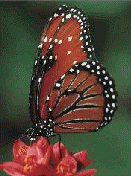|
Monarch Butterfly Becoming Symbol For GE-Free Crops While New Zealanders are waking up to the fact that GE crops (including trees) is not an issue that will `blow over' US researchers at Iowa State University researchers said on Monday they found more evidence that pollen from genetically engineered corn could be deadly for Monarch butterflies, prompting environmentalists to renew demands for tighter restrictions on the crop. The Monarch butterfly is fast becoming a symbol for purity from tampering by bio-scientists in the pay of commerce. The Iowa study published in the journal "Oecologia" comes at a time when the U.S. Environmental Protection Agency has launched its own review of the safety of corn and cotton plants modified to contain a pest-fighting gene. The Clinton administration has faced growing pressure during the past year from consumer and environmental groups, as well as some U.S. trading partners, who say not enough is yet known about the long-term safety of biotech crops. The seed industry and agribusiness contend that gene-spliced crops have undergone thousands of tests and pose no more safety risks than conventional crops. Iowa State researchers John Obrycki and Laura Hansen said their research showed Monarch butterfly caterpillars were seven times more likely to die when they ate milkweed plants carrying pollen from Bt corn, compared to conventional corn. Bt is short for bacillus thuringiensis, a naturally occurring soil bacterium that acts as a pesticide. The gene has been inserted into millions of acres of U.S. corn and cotton plants to repel the European corn borer, bollworms and other pests. The researchers placed potted milkweed plants in and around Bt cornfields to simulate naturally occurring conditions. Pollen from Bt crops also drifts onto nearby plants, including those eaten by harmless insects like the Monarch. The orange and black butterflies are at greatest risk within 10 meters of Bt fields, Obrycki said in an interview. "There exists a good possibility that we will see some mortality of Monarchs in the field," he said. "The level and amount will depend on the timing of when the corn is shedding its pollen and when the Monarch larvae are in the fields." The Iowa study analysed the impact on larvae from two types of Bt corn developed by Novartis AG and sold under the brand names NatureGard and Attribute. The research built upon work by Cornell scientists who created a stir one year ago when they reported Monarch larvae died when fed relatively large amounts of Bt corn pollen in the laboratory.. NOVARTIS SAYS STUDY FLAWED Novartis defended the safety of its Bt corn, saying the new study did not duplicate real-world conditions. "Research conducted outdoors doesn't indicate what happens in a field environment," said Novartis spokesman Rich Lotstein. "The weight of evidence of published and preliminary research indicates that milkweed within one meter of Bt corn fields are highly unlikely to be dusted with toxic levels of Bt pollen." A dozen university researchers stretching from Canada to the Midwestern corn belt are currently studying Bt corn fields and whether the pollen impacts migrating Monarch butterflies. University of Illinois scientists said in June they found no ill effects for black swallowtail butterfly caterpillars who ate pollen from a variety of Bt corn developed by Pioneer Hi-Bred International, a unit of DuPont Co. EPA officials said they would review the new Iowa study, along with other scientific research as part of broad assessment of health and environmental risks for humans, animals, insects and other plants. The agency aims to publish its views by mid-September and will spend the winter months analysing regulations to see what changes, if any, may be needed in buffer zones surrounding Bt fields or other rules. An EPA advisory panel of independent scientists will also weigh in with its own recommendations. "Based on what we've seen so far, we're not seeing any impact on any non-target organism, particularly the Monarch butterfly," Steve Johnson, an EPA deputy assistant administrator, said in an interview. He downplayed environmentalists' concerns about the latest butterfly study. "If we were confronted by information that raised significant public health or environmental issues, then certainly we could take immediate action," Johnson said. "Based on the reviews of all the data that have come in, we don't see any reason to take any kind of action at this time.". GREEN GROUPS WANT MORE Rebecca Goldburg, a scientist with Environmental Defence, said the Iowa research shows farmers should be required to plant 40-foot wide buffer zones around Bt corn fields. "The EPA already requires that farmers growing Bt corn plant 20 percent of their acreage in non-Bt corn, in order to slow the evolution of pests resistant to Bt toxins," Goldburg said. "Planting some or all of this 20 percent acreage as buffer zones would be only a small additional step." Goldburg co-authored a landmark National Academy of Sciences report on biotech crops earlier this year that concluded more long-term research was needed into the potential risks for human and animal health. In addition to the EPA, the U.S. Agriculture Department and the Food and Drug Administration (FDA) are also involved in regulating gene-spliced crops and food. The FDA is expected to issue proposed regulations next month that would require food makers to have mandatory consultations with agency scientists before a biotech food can be marketed. About 20 percent of the U.S. corn crop -- or 15.6 million acres -- was planted with Bt varieties this year, according to U.S. Agriculture Department estimates..
|

